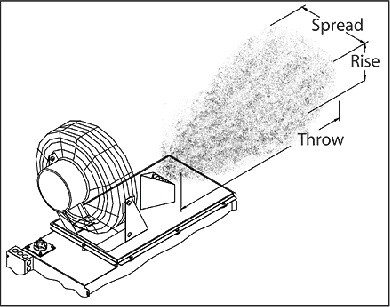
First, some basics about humidifying commercial and industrial spaces:
- To convert a pound of water into vapor requires about 1,000 Btu. This can be accomplished isothermally or adiabatically. Isothermal humidification systems use heat from an external source, such as electricity, natural gas, or boiler steam, to convert water to vapor. Adiabatic humidification systems use heat from the surrounding air to convert water into vapor for humidification (evaporation).
- Isothermal systems disperse into the air either pressurized steam directly from a boiler or unfired steam generator, or nonpressurized steam from a vapor generator (evaporative humidifier). Adiabatic systems disperse into the air mist or fog using pressurized water and/or pressurized air, or water evaporated from a wetted media.
- Both isothermal and adiabatic systems disperse directly into ducts, air handlers, or into open spaces (called area-type systems).
- Absorption distance is the dimension from the leaving side of the dispersion assembly to the point where wetting will not occur. Solid objects such as coils, dampers, or fans beyond this dimension will remain dry, unless they are cooler than the duct air (or space air for area-type systems). Absorption distances in ducts and AHUs are measured in linear inches or feet; area-type systems define absorption distance using rise, spread, and throw dimensions (Figure 1).
It's All Relative
The amount of moisture air can hold correlates directly to air temperature. For example, a pound of air (at sea level) at 55°F containing 20 grains of moisture per pound of dry air has an rh of 31%. That same pound of air at 75° also containing 20 grains of moisture has an rh of 15%, meaning that the air is at 15% of its theoretical capacity to hold moisture. In practice, once air reaches 90% rh, absorption in a typical application becomes unpredictable.When rh reaches 100%, the air is saturated, it has reached its dewpoint, and condensation occurs. Condensation can also occur when moist air comes in contact with objects cooler than the airstream such as cooling coils, turning vanes, elbows, or filters, or even the dispersion assembly. Direct steam injection assemblies typically run steam through jackets surrounding the dispersion tubes to preheat the tube and eliminate condensation. Dispersion tube orifice material is often made from a temperature-neutral material, such as resin, to allow steam to pass through to the air without touching metal. Much effort in humidification system design is focused on condensation, because it causes dripping and wet ducts.
Just as important as temperature is the amount of moisture you plan to disperse (Drh or the difference between entering and leaving rh). The more vapor you need to add, the more volume of air you will need for absorption to occur. In a duct or air handler, this means a longer required absorption distance or warmer air.

Disperse Cold Water Or Hot Steam?
An adiabatic system requires warm air to convert water to vapor and to keep that air above the dew-point. The advantage of adiabatic humidification is that it cools air while humidifying. The drawback is that the cooled air doesn't hold as much moisture as it did when it was warm, and consequently, there needs to be a larger volume of unobstructed air to achieve absorption adiabatically. This means you may need several more feet of duct or AHU length than what is available, or a larger room, if dispersing into an open space (Figure 2).
An isothermal system not only does not need to take Btu out of the air to convert water to vapor, it will typically add heat to the air. Therefore, isothermal systems can disperse in lower temperatures and smaller volumes than adiabatic systems can and still achieve absorption. The advantage with isothermal systems is that absorption can occur within inches in almost any application; the disadvantage is the energy used to heat water to vapor (Figure 3).
When Free Isn't Really Free
Humidifying without adding heat energy, often referred to as "free cooling" because adiabatic humidification can provide up to a 20° temperature drop, is a true benefit in climates where the air is consistently warm and dry, or in environments where there is consistent additional heat generation. However, if cooling the supply air is not desired (as in many winter design applications), or if there is not consistently enough heat in the airstream, energy will be required to preheat the air beyond original design temperatures. And in some applications, air must be cooled after it is heated and humidified to achieve desired conditions.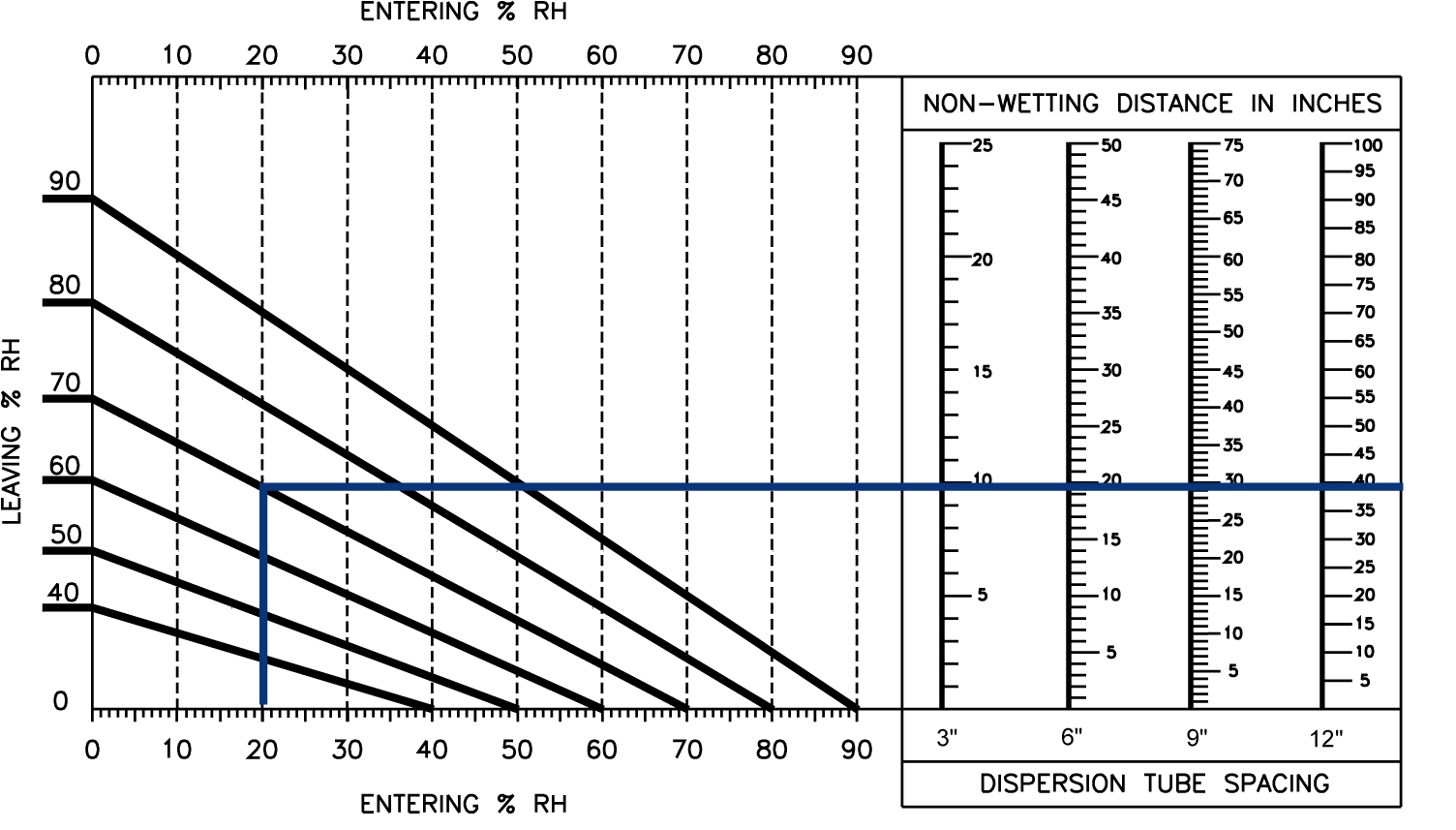
Manage Wetness When Using Adiabatic
Adiabatic fogging systems are frequently used in high-end industrial applications such as semiconductor manufacturing, and in the applications we are aware of, air handlers were designed specifically to accommodate long absorption distances and moisture fallout. Many systems require mist eliminators, which must be maintained to preclude mold growth (the same is true of the wetted-media humidifiers). Most manufacturers of foggers and atomizers recommend drip pans with multiple drains installed under the humidifier; some recommend stainless steel for drain pans and AHU walls and ceilings. Ducts also need special coatings to limit microbial growth and/or they must have maintenance access for cleaning. For these reasons, using an adiabatic system in a retrofit application may be difficult, but a fundamentally wet system such as an adiabatic system can be acceptable if you manage the expected moisture.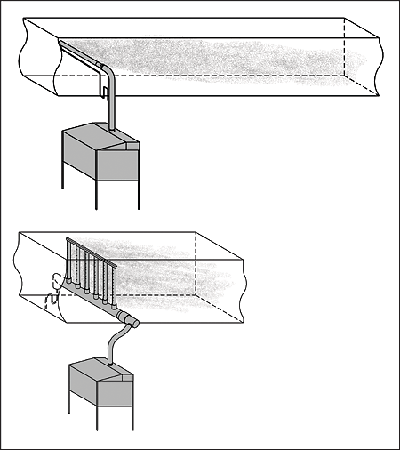
Mix It Up
Water droplet size; the number of mist, fog, or steam discharge points in the airstream; and airflow and velocity also affect absorption.The smaller the water droplet size, the more quickly it will be absorbed. Steam droplets are the smallest, followed by foggers and atomizers. Droplet size is especially relevant to adiabatic humidification, for you may only have the time it takes for a drop of water to fall to the floor for absorption to occur. And if there is no airflow, such as in an area-type application, you have even less time for absorption to occur.
To ensure absorption in a duct or air handler, take advantage of the full airflow. Spread the humidification load among numerous discharge points rather than just a few. For example, Figure 4 shows two different ways to disperse steam into an airstream. Of the examples shown, the single tube dispersion device covers the smallest percentage of the airstream and has the longest absorption distance. Under the same conditions, the multiple tube dispersion assembly achieves absorption in a shorter distance because it has more tubes dispersing the same amount of moisture into the airstream and steam is therefore more evenly distributed. This causes a rapid homogenization of the steam/air mixture, which results in faster re-evaporation or second change of state.
Airflow and velocity also affect absorption. As velocity increases, absorption distance increases. This may become a critical issue if you are trying to humidify with an adiabatic system, which already requires a long absorption distance. And if velocity is too low (such as when airflow is interrupted but the humidifier keeps operating), absorption may not occur at all (an airflow proving switch connected to the humidifier prevents this situation).
In addition, we've found that if absorption does not occur before a duct branch, such as when high velocity air pushes the absorption point beyond the branch, that branch will not be humidified. In an area-type application, fan speeds can become slower than when specified due to mineral buildup or other factors, and this will affect absorption as well. These are all good examples of how absorption can affect your ability to achieve setpoint in the spaces you plan to humidify.
Uniformity of airflow is also important. Turbulence after a fan, changes in velocity at elbows, and air stratification by temperature in open spaces or by velocity in ducts, all affect the ability of air to absorb moisture.
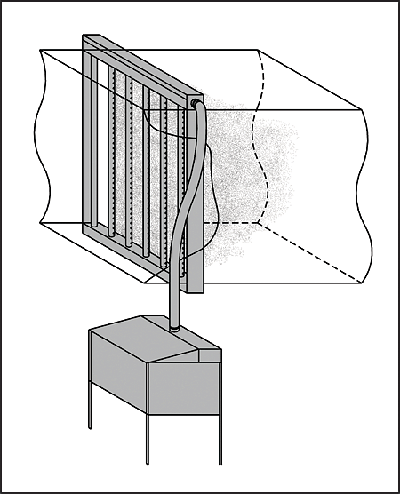
Size Dispersion Assembly For Maximum Load
Figure 5 shows a dispersion assembly that not only has multiple dispersion tubes, but it also has discharge points on both sides of each tube, fully maximizing air and steam mixing to achieve the shortest absorption distance. In addition, this assembly can accommodate large humidification loads because of the dual-header design. Steam enters the top header and condensate leaves by the bottom header. If a dispersion assembly is undersized for the load, steam velocity will push condensate out with the steam, causing dripping. For example, both dispersion assemblies in Figure 4 show condensate drains. The tubes are pitched toward the drains so that condensate naturally flows toward the drain. However, as you increase capacity, there will come a point where the velocity of the steam is great enough to push condensate out with the steam. Carefully review manufacturer sizing charts to ensure that the dispersion assembly is matched to the maximum humidification load.Installation Location Is Critical
The following are guidelines for where to install a steam dispersion assembly, but many of the guidelines apply to adiabatic dispersion. First, check available absorption distance, for this will directly affect system choice. Dispersed moisture must be absorbed into the airflow before it comes in contact with any objects that can cause condensation and dripping. Start with the manufacturer's published absorption distances to choose a dispersion assembly that will ensure absorption within the space you have available. When placing a dispersion assembly in an AHU (Figure 6):
- Location A is the best choice. Installing downstream of heating and cooling coils provides laminar flow through the dispersion assembly; plus, the heated air provides an environment for best absorption. Use a multiple tube dispersion assembly to ensure complete absorption of steam vapor before fan entry.
- Location B is the second choice. However, in season changeover periods, the cooling coil will eliminate some moisture for humidification.
- Location C is the third choice. Air leaving a fan is usually very turbulent and may cause an increased absorption distance. Allow for more absorption distance if installing downstream of a fan.
- Location D is the poorest choice. The cooler air at this location requires an increased absorption distance.
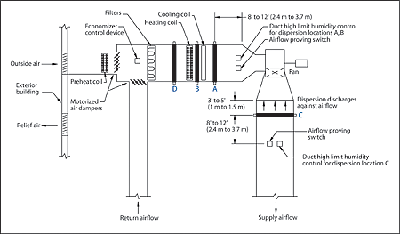
Summary
Air temperature, air volume, air velocity, available absorption distance, and humidification load all affect the capability of air to absorb moisture. If you understand the interrelationships of these factors, you'll have a good understanding of the most critical issue concerning humidification: absorption.ESEDITOR'S NOTE:Some images associated with this article do not transfer to the Internet. To view these images, please refer to the print issue.
